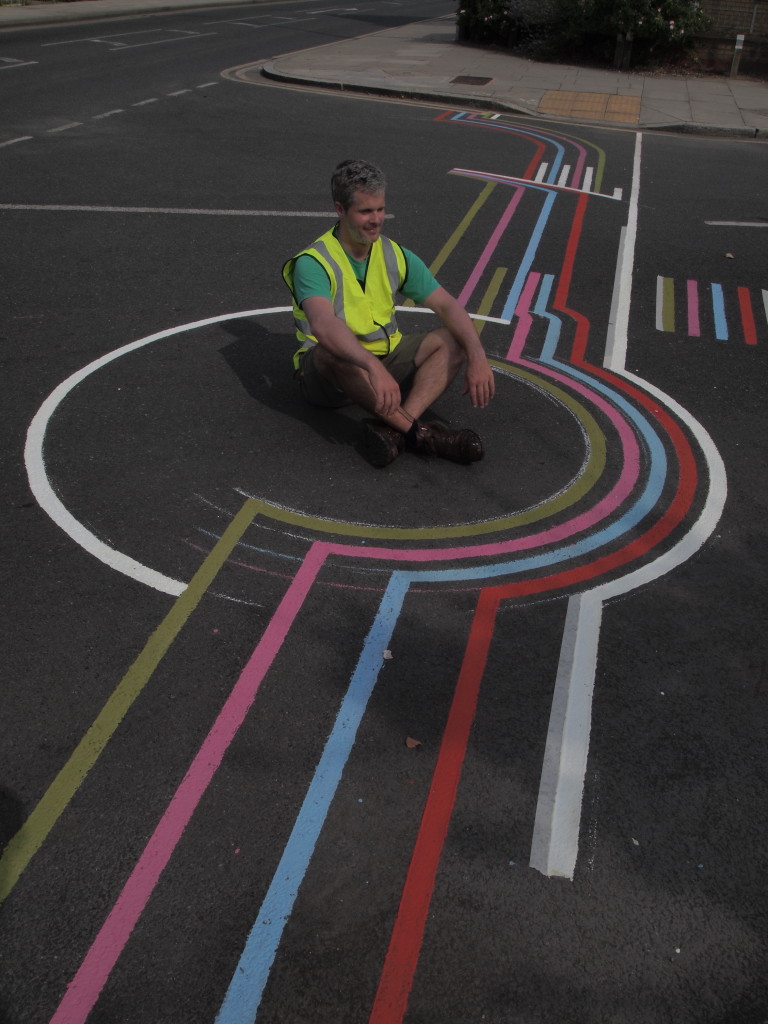 Photo: In London E14, Roadsworth’s homage to musician Cornelius Cardew, who also worked as a graphic designer. He was killed in a hit and run in East London.
Photo: In London E14, Roadsworth’s homage to musician Cornelius Cardew, who also worked as a graphic designer. He was killed in a hit and run in East London.
Roadsworth, who has a decade worth of street art under his belt, has made a recent appearance in the UK – both in London where he created some work around Gloucester Road and Ladbroke Grove and North East England to work on the Street Art Heroes Project. Thanks to Garry Hunter of Fitzrovia Noir, I had the opportunity to interview him about the ways in which street art has changed over the last 10 years, why he paints on roads rather than walls, and a few of the little things that have made him happy over the past month. He also shares photos of his recent work.
 Photo: As above. As a jazz pianist himself, Roadsworth really got into blending street art with these musical scores. He recommends this book about Cornelius or this video if you’re interested in learning more.
Photo: As above. As a jazz pianist himself, Roadsworth really got into blending street art with these musical scores. He recommends this book about Cornelius or this video if you’re interested in learning more.
LO: Tell us a bit about your background.
ROADSWORTH: I live in Montreal. I studied music at university, played in various bands for a while before getting into street art more than 10 years ago. I started doing street art as a form of activism or “guerilla urban planning”, painting fake bike paths around the city. Gradually my approach became more artistic than activist in nature although a certain spirit of activism still informs my practice. Roadsworth is a moniker I chose to pay tribute to an early inspiration of mine, the land artist Andy Goldsworthy. It is also a tongue and cheek reference to the poet Wordsworth. It can also be read literally as “the worth of the road”.
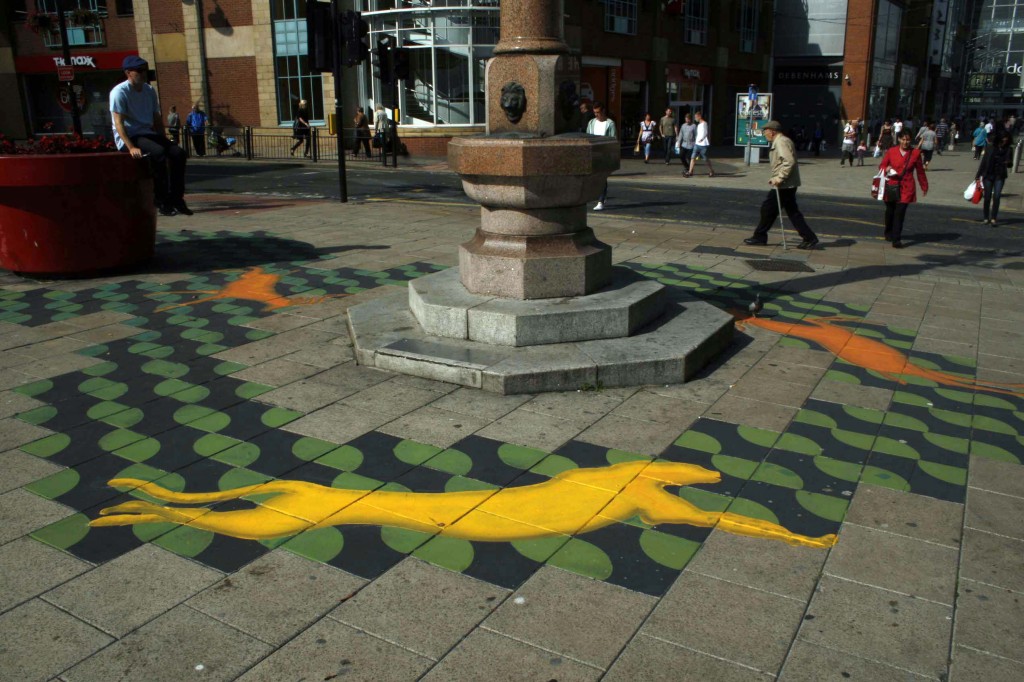 Photo: Roadsworth piece at Park Lane South for #StreetArtHeroes
Photo: Roadsworth piece at Park Lane South for #StreetArtHeroes
LO: What gave you the idea to paint on roads rather than walls? What do you hope to communicate through your work?
ROADSWORTH: I wanted my message to stand out from other graffiti that many city walls are saturated with. Nobody was painting roads at the time and I’ve always found it surprising that more people haven’t exploited them given how ubiquitous they are. I was also interested in subverting what I call the “language of the road” (i.e. road markings). Also, the road epitomizes for me, many aspects of modern society and human psychology in general: capitalism, individualism, denial, isolation, technology vs the body, the environment, etc. Therefore it provides a charged space that seems to somehow energize whatever imagery is introduced to it.
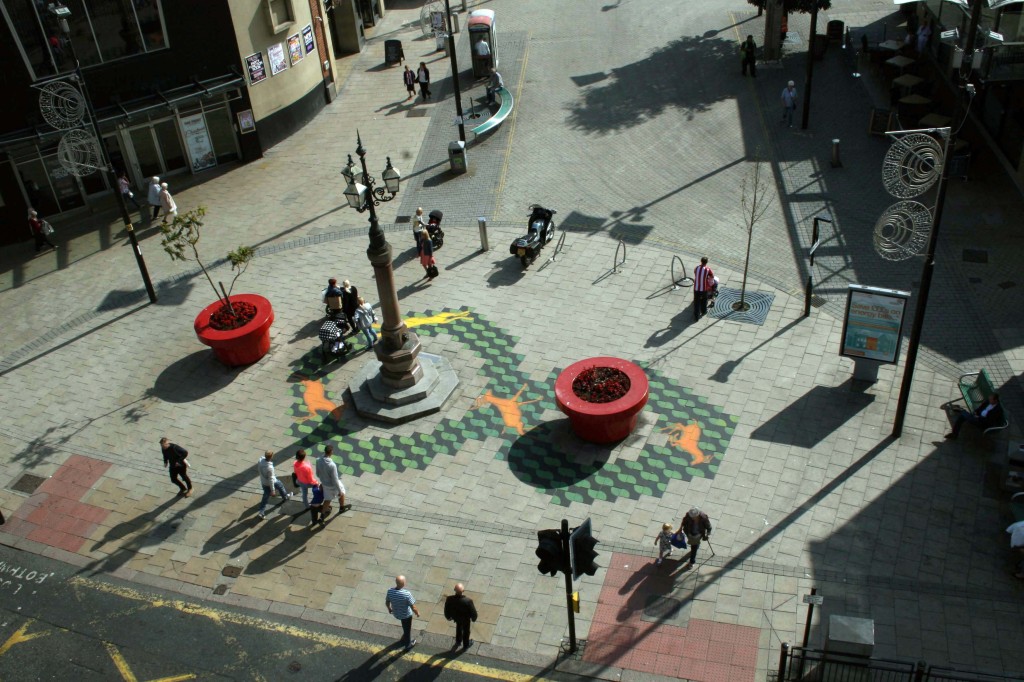 Photo: Roadsworth piece at Park Lane South for #StreetArtHeroes
Photo: Roadsworth piece at Park Lane South for #StreetArtHeroes
LO: What brought you to London last month and North East England this month ?ROADSWORTH: Garry Hunter, founder of Fitzrovia Noir, had featured me in the second volume of his Street Art books so I was already acquainted with him before a chance meeting in Santiago, Chile where we were both involved in different projects. He proposed that I come to London to do some work with him with support from the Kensington Arts Service and Poplar HARCA. He then proposed that I join the roster of artists that he was forming for this Street Art Heroes project (the third part of this 2m 3 year program) in North East England. Since I was previously in Norway, the timing seemed right to come here and continue working together.
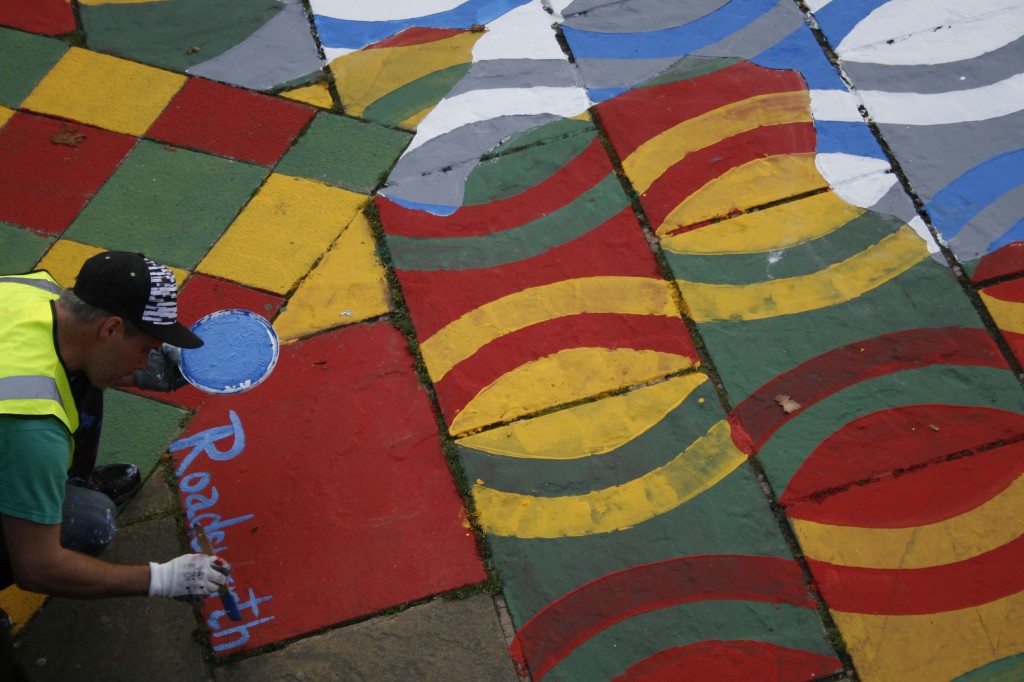 Photo: An abstracted / camouflaged rhino on colours relating to the current Kenyan flag and colonial version that was mainly blue, plus that of Nigerthat representations of desert (yellow) purity (white) and fertile regions (green).
Photo: An abstracted / camouflaged rhino on colours relating to the current Kenyan flag and colonial version that was mainly blue, plus that of Nigerthat representations of desert (yellow) purity (white) and fertile regions (green).
LO: Is there a piece of work you’ve created over the years that stands out to you as one you’re most proud of? What about it makes it special?
ROADSWORTH: Not really. Almost all of the pieces I’ve done have a special significance for me since they all represent a time, a place and the people who I’ve met there. The opportunities for travel and for meeting other artists, curators and people in general is what makes my “job” so appealing and what makes each project unique in some way.
 Photo: As above. This piece ties in with African Festival in Sunderland this month.
Photo: As above. This piece ties in with African Festival in Sunderland this month.
LO: Talk about some of the ways in which street art has changed over the last decade. Are these positive or negative changes? Why?
ROADSWORTH: Yes, street art has changed since I started doing it in 2001 depending, of course, on your definition of “street art”. I have personally always considered street art to be a necessarily illegal activity and a lot of what people refer to as “street art” nowadays, I would simply call mural art or public art. Having said that, there is definitely a movement that has sprung out of street art and street artists, such as myself, that has developed careers as visual artists. These are definitely related phenomenons and there are perhaps stylistic commonalities that unites them all but not as obvious, I don’t think, as in the case of graffiti, for example, which is more founded in some kind of tradition.
 Photo: As above. This Sunderland piece also ties in to the launch of the Street Art Heroes initiative to bring contemporary art to postwar housing estates and areas of the North East rarely exposed to such activities.
Photo: As above. This Sunderland piece also ties in to the launch of the Street Art Heroes initiative to bring contemporary art to postwar housing estates and areas of the North East rarely exposed to such activities.
Street art has really grown up with the internet and has I think experienced a similar exponential rise. The quality and skill of the artists that are painting murals nowadays I think is much more varied and impressive than it was even 10 years ago. I think it was street artists (those painting illegally) and graffiti artists that have paved the way to make more walls and city space in general more accessible to a wider range of artists.
 Photo: As above.
Photo: As above.
Some would say street art has become “corporate” which I think we’ve seen with any movement, form of expression or activity that is popular and that corporations and states for that matter want to endorse and co-opt in some way. The downside to that is that street art has perhaps lost some of its political / transformative potential as the best artists are drawn to “cloistered/controlled” situations where they can practice their art and make a living doing it. That in itself is tranformative and has contributed to level of artistic achievement that we’ve seen in the “street art” world and an increasing openness and appreciation of public art.
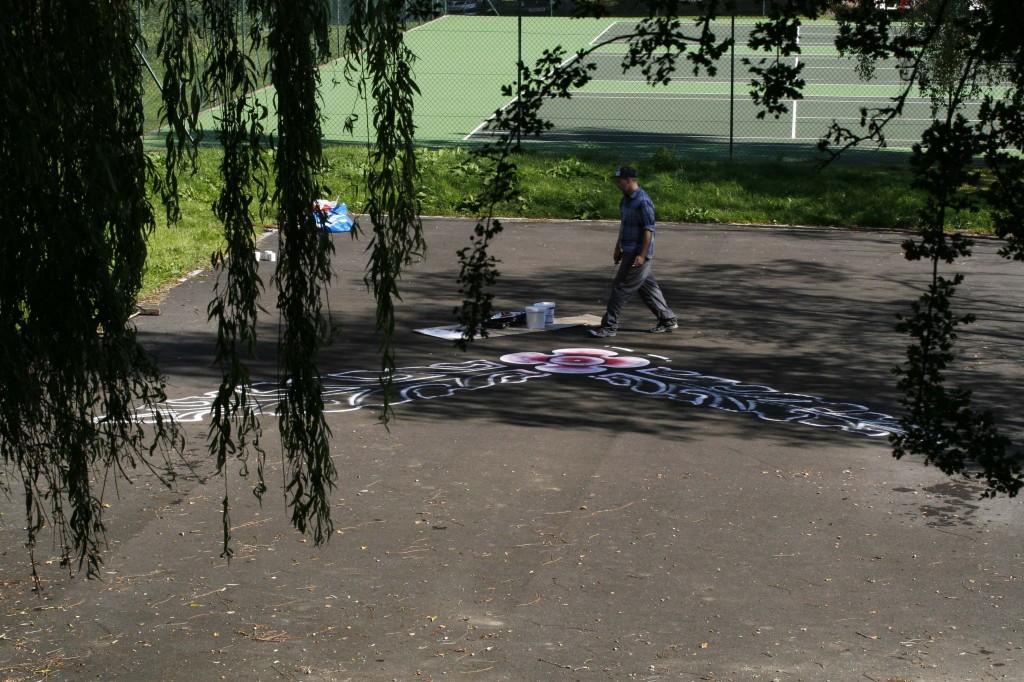 Photo: Some rural street art in the Yorkshire Dales.
Photo: Some rural street art in the Yorkshire Dales.
LO: How is your work received in your home city of Montreal? Where else in the world have you painted and which was most memorable? How does your experience differ in terms of acceptance and interest depending were in the world you go?
ROADSWORTH: When I first starting doing street art in Montreal, I would say it was very well received since it played a fairly significant role in the relative leniency that I enjoyed following my arrest. Many people in the cultural milieu came to my defence in newspaper editorials, for example, and I think this kind of thing helped me a great deal. Surprisingly, my experiences in terms of acceptance and interest hasn’t differed a great deal from city to city, although if I had to make a generalization I would say that European cities in general are more open to art, street art and public art than most American cities. I would say that pretty well every city I’ve ever been to (with the exception of Barcelona before it became “Guliani-anized”) has a zero tolerance to graffiti, street art or any unsanctioned form of expression. Control seems to the rule when it comes to expression.
 Photos: As above. This village of Masham (pronounced Mass-ham) has an interesting history, with some elements of Druid worship remaining in a stone circle built in a forest.
Photos: As above. This village of Masham (pronounced Mass-ham) has an interesting history, with some elements of Druid worship remaining in a stone circle built in a forest.
LO: Tell us about a memorable interaction you’ve had with someone while you were working on a new piece.
ROADSWORTH: The most memorable interaction I have had was actually caught on film. I was in Amsterdam doing a piece on the road and a woman was talking to me from an upstairs window telling me she didn’t want graffiti on her street and that she was going to call the police. She then picked up the phone and called the police and even announced the fact to me but I didn’t learn this until I saw the footage after the fact. I didn’t hear her because I guess I was busy trying to finish the piece as quickly as possible. Anyway it’s memorable because the police did show up and I spent the night in an Amsterdam jail cell only to be released with barely enough time to catch my return flight the next morning.
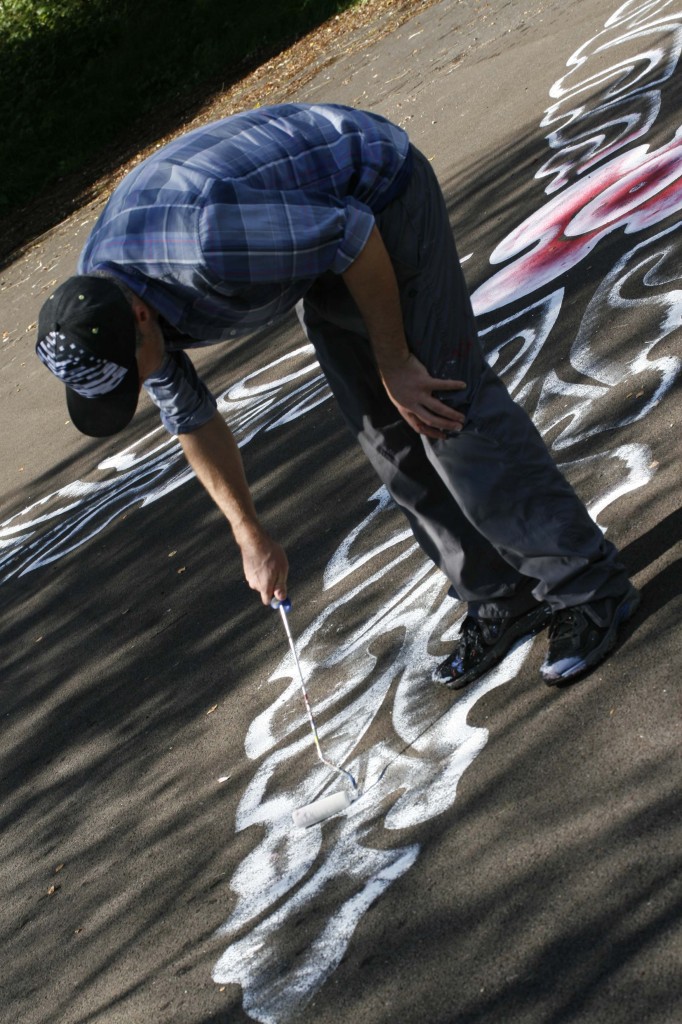 Photo: As above. A twist on the typical urban street art with which we are so familiar.
Photo: As above. A twist on the typical urban street art with which we are so familiar.
LO: Why is street art important?
ROADSWORTH: Street art is important, especially in the realm of physical public space, because it provides an alternative form of media to the otherwise homogenous media we’re subject to in the form of advertising and state signage. Public space is extremely important because it is in fact our only common space and it should allow for a diverse range of opinions, expression, perspectives and reflect our so-called democratic values rather than the private interests of corporations and the state’s prerogative for control.
 Photo: At a St Oswalds school workshop with 27 Year 6, 11-year-old pupils, most of whom live on the surrounding estate that has streets named after famous artists like Landseer, Rembrandt, Turner, Rubens, etc.
Photo: At a St Oswalds school workshop with 27 Year 6, 11-year-old pupils, most of whom live on the surrounding estate that has streets named after famous artists like Landseer, Rembrandt, Turner, Rubens, etc.
LO: How do you start your day? And how do you wind down at night?
ROADSWORTH: With very strong coffee. Wind down with good book or movie.
 Photo: As above. The Hive idea was developed with the children’s form teacher Dominic Woodhouse as an area of the playground where the children can work together, nurture and grow – just like bees.
Photo: As above. The Hive idea was developed with the children’s form teacher Dominic Woodhouse as an area of the playground where the children can work together, nurture and grow – just like bees.
LO: Little Observationist is all about appreciating the little things in life. Share three little things that made you happy over the past month.
ROADSWORTH:
1) Drinking Aquavit with the good people of Skarnes in Norway
2) Walking down the South-Shields pier just before sunset
3) Seeing the enthusiasm of the kids of St Oswald’s school on Whiteleas Estate, where we did a workshop
Thanks Roadsworth!
For more about Roadsworth and his work, check out his website.
Photos were provided by Garry Hunter.

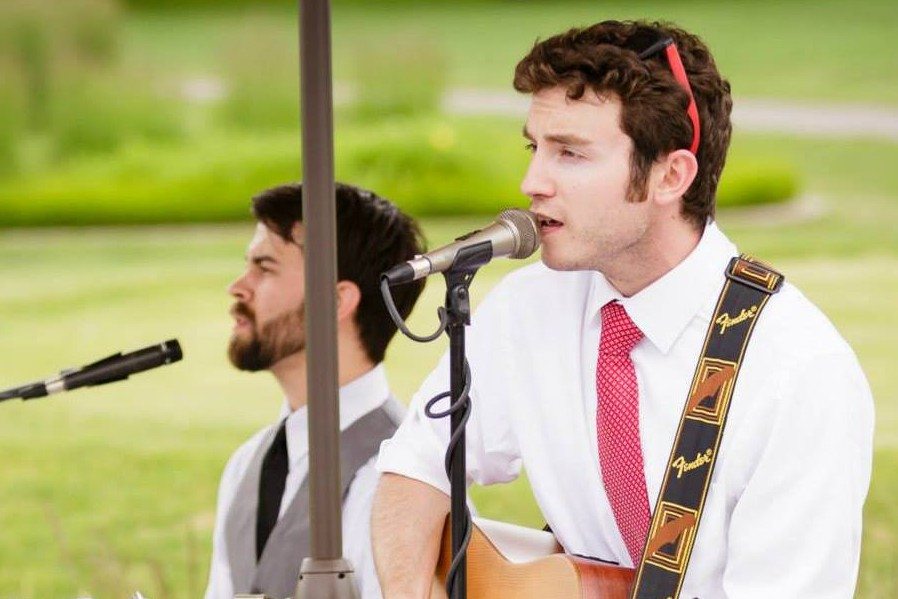
No Comments